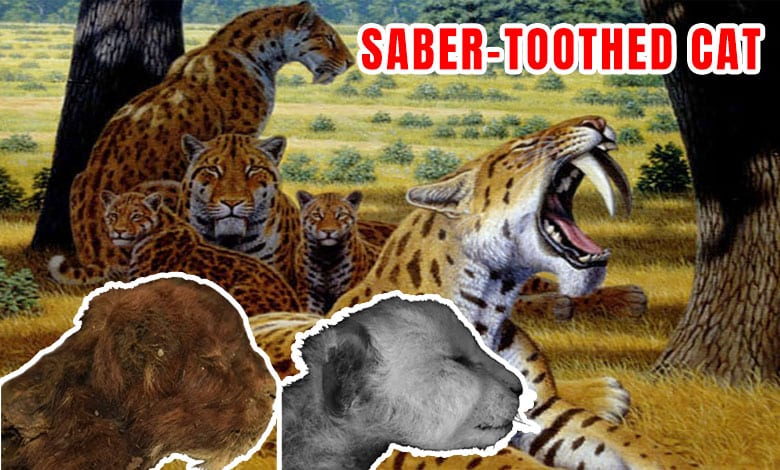Scientists Unveil Perfectly Preserved 35,000-Year-Old Saber-Toothed Cat Kitten in Siberian Permafrost: Video
In a groundbreaking discovery, scientists have uncovered the mummy of a Saber-toothed cat (Homotherium latidens) preserved in the permafrost of Siberia, offering a rare glimpse into the life of an Ice Age predator.

Siberia: In a groundbreaking discovery, scientists have uncovered the mummy of a Saber-toothed cat (Homotherium latidens) preserved in the permafrost of Siberia, offering a rare glimpse into the life of an Ice Age predator. The 35,000-year-old kitten, just three weeks old at the time of death, is the most well-preserved specimen of its kind ever found, providing unprecedented insight into this extinct species that once roamed the Earth during the Pleistocene epoch.
Table of Contents
Perfect Preservation of an Ancient Predator
The Homotherium latidens kitten, discovered in the Siberian tundra, is remarkably well-preserved, with its whiskers, claws, and thick fur still intact. Researchers estimate that the animal, which was likely born in a cold, Ice Age environment, lived in Siberia around 35,000 years ago. Despite the passage of millennia, the preservation of the kitten’s head and upper body, along with surrounding ice that encased its pelvic and leg bones, has astonished scientists. This discovery is a rare opportunity for paleontologists to study a young Saber-toothed cat in its natural state, providing invaluable information about its anatomy and environment.
New Insights into Homotherium latidens
Homotherium latidens, also known as the “scimitar cat,” was a formidable predator of the Pleistocene era. Unlike the more famous Smilodon species, Homotherium had shorter, serrated canine teeth and was built with a more robust body, suited for hunting large herbivores in harsh, icy landscapes. The preserved kitten is a unique specimen that helps scientists better understand the species’ behavior, physical adaptations, and ecological role during the Ice Age.
Also Read: How viral, duct-taped banana came to be worth USD 1 million
Adapting to Ice Age Climates
One of the most significant revelations from this discovery is the kitten’s adaptations to the extreme cold of the Ice Age. Comparative analysis with modern big cats, such as lions, shows several key differences. The Homotherium kitten exhibited wide paws and lacked carpal pads, features that would have helped it navigate snowy, frozen terrain. Its thick fur coat would have provided essential protection against the bitter cold, allowing the kitten to survive in the harsh climates of the late Pleistocene.
Scientists believe these features point to the species’ ability to thrive in some of the most challenging environments on Earth, helping them hunt and survive in the frozen landscapes of prehistoric Siberia.
Wider Distribution of Saber-Toothed Cats in Eurasia
The discovery challenges previous assumptions about the geographic range of Homotherium latidens, which was thought to have been limited to warmer regions. The well-preserved remains of this kitten, found in Siberia, suggest that the species had a far broader distribution across Eurasia during the Late Pleistocene, surviving in areas previously believed to be inhospitable.
The implications of this finding are vast, offering a new perspective on how Ice Age predators adapted to different environments. Researchers now have an opportunity to explore the evolutionary history of Homotherium and its relationship to other saber-toothed cats, which may unlock more secrets about the evolution of these ancient predators.
Genetic Research Could Reveal New Secrets
The incredible preservation of the kitten’s remains also opens the door for groundbreaking genetic research. DNA extracted from the specimen could provide deeper insights into the genetic makeup of Homotherium latidens, revealing more about its evolutionary path and how it relates to other saber-toothed species, such as Smilodon and modern big cats.
The study of ancient DNA is already transforming our understanding of extinct species, and this discovery could help piece together the puzzle of why these powerful predators eventually disappeared from the planet.
A Breakthrough for Ice Age Research
This extraordinary find is a major milestone in Ice Age research, offering a clearer window into the life of one of the most iconic predators to ever walk the Earth. The Homotherium latidens kitten’s remarkable preservation challenges our understanding of the species’ adaptations, behaviors, and distribution across prehistoric Eurasia.
As researchers continue to study this well-preserved mummy, new details about the lives of Ice Age animals are sure to emerge, enriching our understanding of the prehistoric world and the environmental challenges these creatures faced.
Conclusion
The discovery of a perfectly preserved Saber-toothed cat kitten in Siberian permafrost not only adds a new chapter to the history of Ice Age predators but also opens up new avenues for genetic research and evolutionary studies. With more information to come, this find is set to be one of the most important discoveries in the field of paleontology in recent years.
